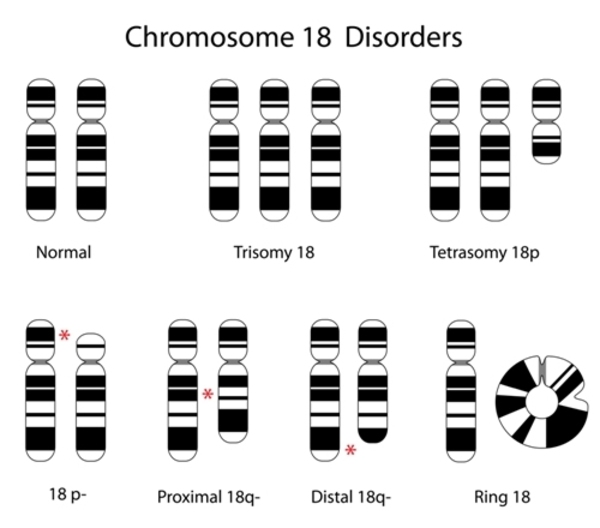18q deletion syndrome
what is 18q deletion syndrome
A chromosomal disorder that develops when a part that is located on the longest (q) part of chromosome18 is missing . The word “distal” means that the missing piece is located near the side of the chromosome. Distal 18q deletion syndrome may cause a variety of symptoms and signs in those affected.

The most common symptoms of the distal 18q deletion syndrome are short height (often due to deficiency of growth hormone) and a weakening of muscular tone (hypotonia) hearing loss because of the ear canals being small (aural narrowing) or not present (aural atresia) and foot abnormalities like an inward or forward-bounding feet (clubfoot) as well as feet that have soles that are round to the outside (rocker-bottom feet). Eye movement disorders, as well as other eye problems, such as openings in the roofs of mouths (cleft palate) as well as an underactive thyroid gland (hypothyroidism) and heart problems that occur from birth (congenital heart problems) kidney disorders or genital disorders, as well as skin issues can also be present in this condition. A few affected people have mild facial features like the deep set eyes as well as a sunken or flat appearance in midface (midface hypoplasia) and a mouth that is wide as well as prominent ears. These characteristics are usually not evident unless they are part of a thorough medical examination.
Distal 18q deletion syndrome may be a threat to the nerve system. A typical neurological symptom of this disorder is the impairment in myelin manufacturing (dysmyelination). Myelin is a fatty chemical that protects nerve cells and facilitates the speedy transmitting of nerve signals. The creation of myelin sheath that protects nerve cells (myelination) typically begins prior to the birth and continues throughout adulthood. For those suffering from the distal 18q syndrome myelination may be delayed or occurs more slowly than usual and affected individuals might not have normal adult levels of myelin. The majority of people suffering from the distal 18q syndrome experience neurologic issues, but it is not known whether these problems are due to the dysmyelination. These issues can be caused by the delayed development of children as well as learning disabilities and intellectual disabilities that range from moderate to severe. Hyperactivity, seizures, mood disorders, such as anxiety, irritability, or depression; and other symptoms of autism spectrum disorders that affect social communication and interaction can also happen. Certain individuals with autism are born with a small head dimension (microcephaly).
Incidence
Deletions in the Q arm of chromosome18 are found in approximately one of 55,000 infants in the world. The majority of these deletions occur in the distal part in the q arm which can lead to the distal 18q deletion syndrome.
Causes
The distal 18q deletion syndrome caused by a loss of DNA from a single version of the chromosome located between a region known as 18q21 to at the end of the chromosome. The extent of the deletion as well as the location at which it begins varies among affected people. The symptoms and signs of the distal 18q syndrome are believed to be due with the disappearance of several genes Some of which are not known, in this particular region of chromosome 18. Certain aspects of the disorder are linked to the loss of certain genes within this region. People who have deletions that contain the TCF4 gene typically exhibit symptoms and signs of a different genetic condition called Pitt-Hopkins syndrome. This includes severe intellectual disabilities and breathing issues along with other symptoms of the distal 18q deletion disorder.
Inheritance
The distal 18q deletion disorder is believed to be an autosomal dominating disease that means that only one duplicate of the deleted region on chromosome 18 within each cell is enough to trigger the disorder’s hallmark traits.
The majority of cases of the distal 18q deletion syndrome result from an entirely new (de new) deletion, and they are not passed down through the generations. The deletion is most likely to occur as a result of a random event that occurs during the creation in reproductive cells (eggs or sperm) or during early embryo development. The affected individuals typically do not have a any history of the disorder within their families.
In certain cases dital 18q deletion may be passed down from a parent who is affected, with minimal symptoms and signs. It can also be acquired from an unaffected parent that is carrying a chromosomal rearranged gene known as a balanced translocation where no genetic material is acquired or lost. People who have an unbalanced translocation don’t typically suffer from any health issues, however, the translocation may become imbalanced as it’s passed on to children of the following generation. Children born with unbalanced translocations may have an chromosomal re-arrangement with the addition of or absence of genetic material. The inheritance of an unbalanced translocation which results in the removal of genes from the distal portion of the q arm of chromosome18 causes the distal 18q deletion syndrome.
